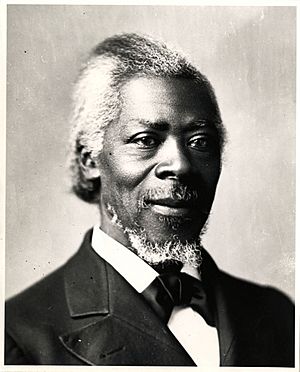William Lambert (abolitionist) facts for kids
Quick facts for kids
William Lambert
|
|
|---|---|
 |
|
| Born | 1817 Trenton, New Jersey, U.S.
|
| Died | April 28, 1890 (aged 72–73) Detroit, Michigan, U.S.
|
| Resting place | Elmwood Cemetery (Detroit), Detroit |
| Occupation |
|
| Known for |
|
| Children | 6 |
William Lambert (born 1817, died 1890) was an important African-American leader and abolitionist in Detroit during the 1800s. He had a good education and started fighting against slavery when he was young. For over 50 years, he was a very important person in Detroit's black community and the city itself. In the late 1840s, Lambert helped a person escape slavery and reach Canada from Detroit. This event played a part in a law called the Fugitive Slave Act being passed in 1850.
Contents
Early Life and Education
William Lambert was born free in 1817 in Trenton, New Jersey. It is believed that at least one of his parents was free when he was born, and possibly both. A Quaker schoolmaster named Abner Hunt Francis helped Lambert get a valuable formal education. This teacher was also an abolitionist, meaning he was against slavery. He introduced Lambert to the anti-slavery movement at a young age.
In the 1830s, Lambert and Francis were in Buffalo, New York. This city was a key place for the abolitionist movement at that time. From 1832 to 1838, while his mentor worked against slavery in Buffalo, Lambert started his own journey. He traveled the Great Lakes region and Detroit, working as a cabin boy on commercial ships.
Between 1838 and 1840, Lambert settled permanently in Detroit. Even though he was only in his early 20s, he quickly became involved in local businesses and groups working for civil rights.
Business Success in Detroit
Lambert's first steady job in Detroit was in a tailor shop. He might have chosen this work because his mentor, Abner Francis, was also a tailor. In that shop, he met George DeBaptiste. Lambert and DeBaptiste became close friends and worked together in the local part of the Underground Railroad. They also worked on other projects to end slavery in Detroit.
Lambert also found success in the clothing business. He eventually owned his own successful tailoring and dry cleaning business. By the time he died in 1890, his businesses had made him quite wealthy.
Fighting for Freedom: Abolitionist Work
After settling in Detroit, William Lambert quickly joined local groups that fought for civil rights and against slavery. He had the skills and inspiration to become a leader in these groups. His formal education and his childhood spent with abolitionists like Abner Francis, Henry Highland Garnet, and Frederick Douglass prepared him well.
By 1842, Lambert was a key figure in local black politics. He and two other men formed the Colored Vigilant Committee. This committee worked to gain rights and freedom for black people in Michigan. Lambert drafted and delivered many of the petitions and statements for this group. One of his early goals was for black men to have the right to vote. Some sources even say he believed all men should have the right to vote, no matter their social class or race.
Lambert became well-known for his powerful work in local politics. However, in 1847, he gained fame on a national level. By this time, Lambert was a "conductor" on the Underground Railroad. This meant he helped people escape slavery. At least one of his businesses was a safe house for those seeking freedom.
In 1847, a man named Robert Cromwell was trying to escape slavery. He was heading to Windsor, Canada, through Detroit, using Lambert's part of the Underground Railroad. Cromwell's owner, John Dun, was chasing him closely. But Lambert's influence in Detroit was strong enough to have Dun put in jail. This delay allowed Cromwell to escape safely into Canada.
Later, Lambert commented on how his lawyers managed to get Dun jailed. He said, "our law point was bad, but were numerous and resolute." This meant their legal argument was weak, but they had many determined people helping. Dun was later released from jail because the reasons for his arrest were not strong. However, it was too late to catch Cromwell.
Lambert's success in helping Cromwell escape was amazing. Just 14 years earlier, a crowd of black community members tried to protest the capture of another escaped slave. That protest ended with the mayor calling in federal troops to break up the crowd. Lambert's bold actions in helping Cromwell, and their success, had a big impact. These events helped lead to the Fugitive Slave Act being passed three years later in 1850. This law made it harder for enslaved people to escape and required citizens to help catch them.
Later Life and Passing
In his last few months, William Lambert seemed to be suffering from an illness that affected his brain, possibly due to old age. He started having trouble knowing where he was. For example, one morning he was found at an old business place, having wandered from his home during the night.
William Lambert was buried at Elmwood Cemetery on April 30, 1890. Many other Detroit abolitionists are also buried there, including George DeBaptiste, Lambert's long-time friend and partner in the Underground Railroad.
See also
- Civil rights movement (1865–1896)
- List of African-American abolitionists
- List of people from Detroit

